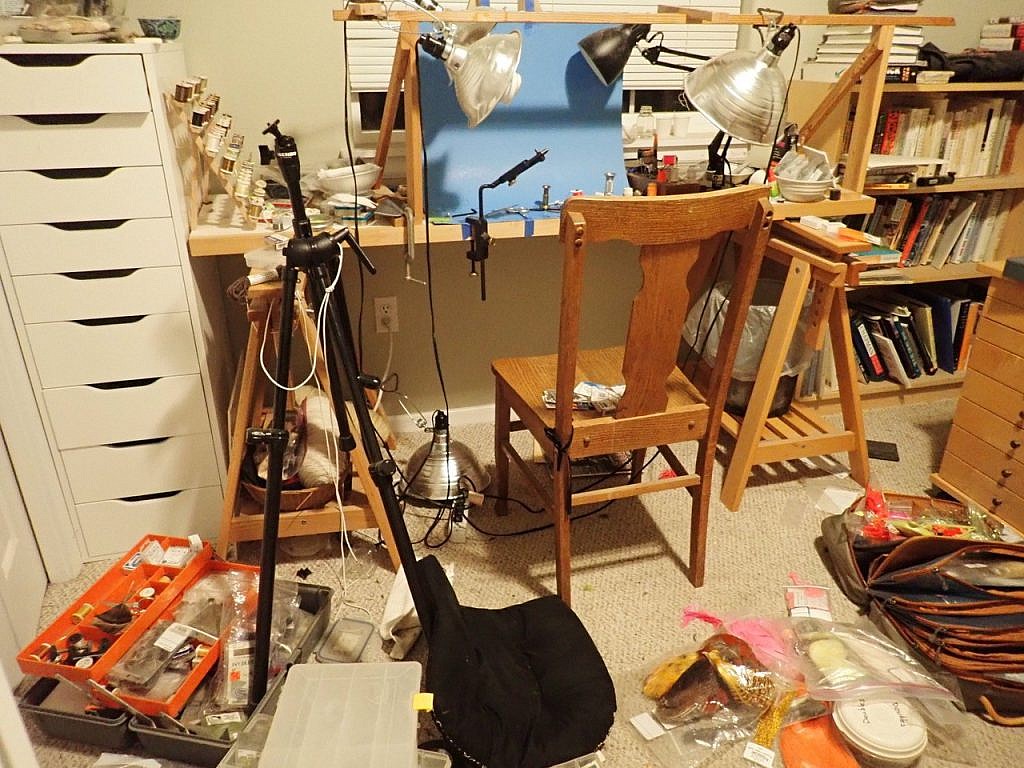
by Scott Sadil
Every writer who has ever indulged us with insights into the noble craft of fly tying will inevitably offer one important piece of advice: maintain a tidy bench or tying station.
Better yet, after any tying session, or on completing any specific pattern, put away unused materials, set aside your tools and, if you’re starting another pattern, select only the materials you’ll now need and arrange them neatly in front of you.

That’s the advice. Everyone has heard it.
But who actually does it?
Here’s my buddy Dave Hughes on the subject:
Get in the habit of cleaning away the materials from the last fly you tied before you lay
out the materials to begin a new one. Of course, I never follow this strictly, and you probably
won’t either. But the degree to which you approximate this ideal will predict the sort of mess
you’re surrounded by when you tie. The less cluttered your tying area, the more likely you’ll
be able to find what you need among the myriad tools and materials.
(From Hughes’s Trout Flies)
As in all things fly fishing, it’s easy to see how this specific lesson might apply to one’s larger life, as well.
Still, many of us resist. I recall hearing Henry Hoffman, the chicken breeder, talk about tying flies commerically and making adjustments with his tools or materials so that his hands moved, say, six inches instead of eight when he was working on one step in a particular pattern. Subtract those two inches again and again and again over the course of tens of dozens of flies, or an entire day, and you could easily imagine the distance saved – or how much more time he now had to tie more flies. If work equals force times distance . . . .

I’ve always hated thinking like that. Especially when it comes to speculative, creative work. The whole point of sport, for some of us, is that it can’t be reduced to equations, efficiency quotients, recipes for success—that the unknown looms large and your capacity to improvise, in the here and now, remains the deepest source of whatever it is we’re really after.
Or, to paraphrase Quincy Jones, who wanted almost all, but not everything, tightly arranged before stepping into the recording studio: You want to leave a little room for spirit to move.
Yet we all know that Hughes et al. speak the truth: You do need to keep after the chaos that can threaten, at any moment, to overwhelm your fly tying station. Tidying up before starting a new pattern is a good place to begin, especially if you happen to be an angler fortunate enough to need flies for a wide range of fishing opportunities—for trout and salmon, for winter steelhead and summer steelhead, for warmwater and saltwater species, for the surf, for bluewater, for lakes and rivers and streams.
You can see how it happens. One good non sequitur and discipline crumbles. Take that tendency far enough and the next thing you know you have wads of hooks and fur and feathers piled up on the carpet; climbing into the tying chair feels like squeezing into the cockpit of a small plane.
And what about the rest of the house? A pile of Baja rods and reels there, another pile for winter steelhead next to that. Trout rods and vest and waders and a bag of reels over there. That’s boat stuff in that pile, sporting literature over there. Packs, jackets, maps. Socks, charts, hats.
Your bench, you realize, might just be a symptom of another, larger, problem.
It’s a good wintertime cold-snap job. Even if it does mean two trips to IKEA. A little order never hurt anybody? True enough—although, sadly, each new set of drawers, and each new storage cabinet, means it’s that much more unlikely I’ll find space enough to loft the next boat on sheets of plywood covering the living room and dining room floor—my favorite place, I’ve found, for tackling the job.
Gray’s angling editor Scott Sadil thinks learning to tie flies, if you’re a fly angler, is as important as learning to cook.
